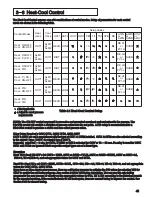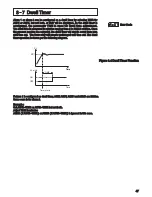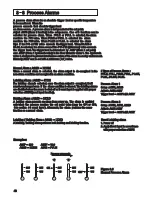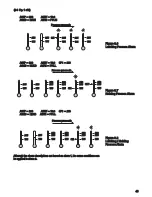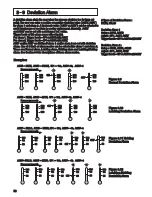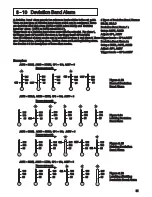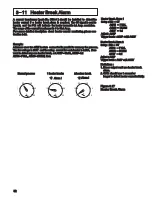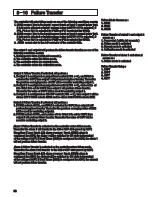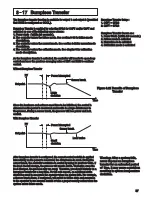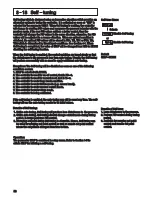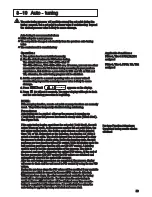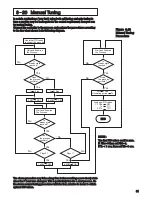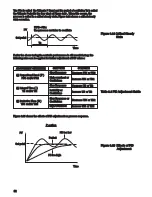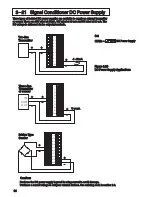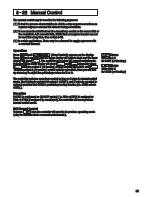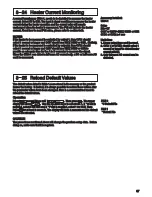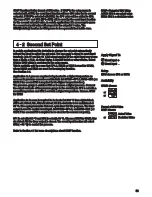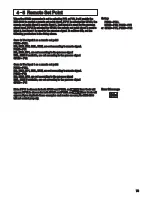
3 18 Self
tuning
3 18 Self
tuning
Self-tune Menu
Self-tune Menu
Selects
Disable Self-tuning
Disable Self-tuning
Enable Self-tuning
Enable Self-tuning
or
58
Self-tuning which is designed using an
provides an
alternative option for tuning the controller. It is activated as soon as “YES” is
selected for the parameter SELF. When Self-tuning is working, the controller
will change its working PID values and compares the process behavior with the
previous cycle. If the new PID values achieve a better control, then the
controller will change the PID values in the same direction, otherwise, the PID
values will be adjusted in a reverse direction. When an optimal condition is
obtained, the optimal PID values will be stored in PB1, TI1, TD1 or PB2, TI2,
TD2 which is determined by Event Input conditions. See
. When
Self-tuning is completed, the value of SELF will be changed from YES to NONE
disabling the self-tuning function.
innovative algorithm which
Section 4-1
Self-tuning which is designed using an
provides an
alternative option for tuning the controller. It is activated as soon as “YES” is
selected for the parameter SELF. When Self-tuning is working, the controller
will change its working PID values and compares the process behavior with the
previous cycle. If the new PID values achieve a better control, then the
controller will change the PID values in the same direction, otherwise, the PID
values will be adjusted in a reverse direction. When an optimal condition is
obtained, the optimal PID values will be stored in PB1, TI1, TD1 or PB2, TI2,
TD2 which is determined by Event Input conditions. See
. When
Self-tuning is completed, the value of SELF will be changed from YES to NONE
disabling the self-tuning function.
innovative algorithm which
Section 4-1
When the Self-tuning is enabled, the control variables are tuned slowly so that
the disturbance to the process is less than auto-tuning. Usually, the Self-tuning
will perform successfully with no need to apply additional auto-tuning.
When the Self-tuning is enabled, the control variables are tuned slowly so that
the disturbance to the process is less than auto-tuning. Usually, the Self-tuning
will perform successfully with no need to apply additional auto-tuning.
Exceptions: The Self-tuning will be disabled as soon as one of the following
conditions occurs:
1. SELF is selected with NONE.
2. The controller is used for on-off control, that is PB=0.
3. The controller is used for manual reset, that is TI=0.
4. The controller is under loop break condition.
5. The controller is under failure mode (e.g. sensor break).
6. The controller is under manual control mode.
7. The controller is under sleep mode.
8. The controller is being calibrated.
Exceptions: The Self-tuning will be disabled as soon as one of the following
conditions occurs:
1. SELF is selected with NONE.
2. The controller is used for on-off control, that is PB=0.
3. The controller is used for manual reset, that is TI=0.
4. The controller is under loop break condition.
5. The controller is under failure mode (e.g. sensor break).
6. The controller is under manual control mode.
7. The controller is under sleep mode.
8. The controller is being calibrated.
If the self-tuning is enabled, the auto-tuning can still be used any time. The self-
tuning will use the auto-tuning results for its initial values.
If the self-tuning is enabled, the auto-tuning can still be used any time. The self-
tuning will use the auto-tuning results for its initial values.
Unlike auto-tuning, Self-tuning will produce less disturbance to the process.
Unlike auto-tuning, Self-tuning doesn't change control mode during tuning
period. It always performs PID control.
Changing set point during Self-tuning is allowable. Hence, Self-tuning can
be used for ramping set point control as well as remote set point control
where the set point is changed from time to time.
Unlike auto-tuning, Self-tuning will produce less disturbance to the process.
Unlike auto-tuning, Self-tuning doesn't change control mode during tuning
period. It always performs PID control.
Changing set point during Self-tuning is allowable. Hence, Self-tuning can
be used for ramping set point control as well as remote set point control
where the set point is changed from time to time.
Benefits of Self-tuning:
Benefits of Self-tuning:
1.
2.
3.
Default
SELF=NONE
Default
SELF=NONE
Benefits of Self-tune:
1. Less disturbance to the process.
2. Perform PID control during tuning
period.
3. Available for ramping set point
control and remote set point
control.
Benefits of Self-tune:
1. Less disturbance to the process.
2. Perform PID control during tuning
period.
3. Available for ramping set point
control and remote set point
control.
Operation:
Section 1-5
The parameter SELF is contained in setup menu. Refer to
to
obtain SELF for initiating a self-tuning.
Operation:
Section 1-5
The parameter SELF is contained in setup menu. Refer to
to
obtain SELF for initiating a self-tuning.


